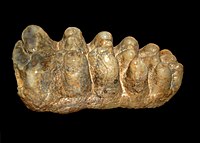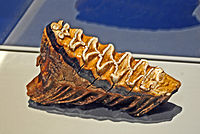Elephantidae
| Elephantidae Temporal range:
| |
|---|---|
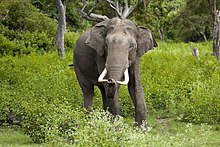
| |
| A male Asian elephant (Elephas maximus) in the wild at Bandipur National Park in India | |
| Scientific classification | |
| Domain: | Eukaryota |
| Kingdom: | Animalia |
| Phylum: | Chordata |
| Class: | Mammalia |
| Order: | Proboscidea |
| Superfamily: | Elephantoidea |
| Family: | Elephantidae Gray, 1821 |
| Type genus | |
| Elephas | |
| Genera[3] | |
| |
| Synonyms[4] | |
| |
Elephantidae is a
The family was first described by John Edward Gray in 1821,[5] and later assigned to taxonomic ranks within the order Proboscidea. Elephantidae has been revised by various authors to include or exclude other extinct proboscidean genera.
Description
Elephantids are distinguished from more primitive proboscideans like
-
Molar of Tetralophodon, a "tetralophodont gomphothere"
-
Worn molar of Stegotetrabelodon, a primitive elephantid
-
Molar of a modern African bush elephant (Loxodonta africana)
-
Tooth of Mammuthus sp.
Classification

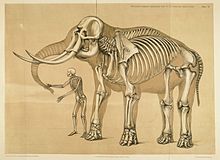
Some authors have suggested to classify the family into two subfamilies, Stegotetrabelodontinae, which is monotypic, only containing Stegotetrabelodon, and Elephantinae, containing all other elephantids.
Living species
- Loxodonta(African)
- L. africana African bush elephant
- L. cyclotis African forest elephant
- Elephas (Asiatic)
- E. maximus Asian elephant
- E. m. maximus Sri Lankan elephant
- E. m. indicus Indian elephant
- E. m. sumatranus Sumatran elephant
- E. m. borneensis Borneo elephant
- E. maximus Asian elephant
Classification
- Elephantidae
- †Stegotetrabelodon (3 species)
- Subfamily Elephantinae
- †Primelephas (2 species)
- Elephas (7+ species)
- †Stegoloxodon (2 species)
- Loxodonta(6 species)
- †Palaeoloxodon (14+ species)
- †Phanagoroloxodon (1 species)
- †Mammuthus(10 species)
- †Stegodibelodon (1 species)
- †Selenetherium (1 species)
Evolutionary history
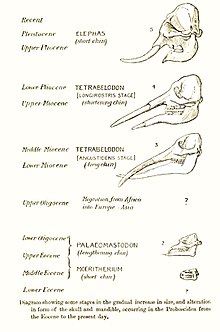
Elephantids are thought to have evolved from gomphotheres, with some authors proposing the most likely ancestors to be African species of the "tetralophodont gomphothere" Tetralophodon.[11] The earliest members of the family, are known from the Late Miocene, around 9–10 million years ago.[12] The modern genera of elephants and mammoths had diverged from each other by the end of the Miocene, around 5 million years ago. Elephantids began to migrate out of Africa during the Pliocene, with mammoths and Elephas arriving in Eurasia around 3–3.8 million years ago.[13] Around 1.5 million years ago, mammoths migrated into North America.[14] At the end of the Early Pleistocene, around 0.8 million years ago, Palaeoloxodon migrated out of Africa, becoming widespread across Eurasia, from Western Europe to Japan.[15] Palaeoloxodon and Mammuthus became extinct during the Late Pleistocene-Holocene, with the last population of mammoths persisting on Wrangel Island until around 4,000 years ago.[16]
See also
References
- ^ H. T. Mackaye, M. Brunet, and P. Tassy. 2005. Selenetherium kolleensis nov. gen. nov. sp.: un nouveau Proboscidea (Mammalia) dans le Pliocène tchadien. Geobios 38(6):765-777
- .
- .
- JSTOR 1006229.
- ^ Gray, John Edward (1821). "On the natural arrangement of vertebrose animals". London Medical Repository. 15: 297–310.
- S2CID 883007.
- PMID 37580434.
- ^ S2CID 245067102, retrieved 2023-11-21
- S2CID 214094348.
- PMID 29483247.
- S2CID 202024016.
- ^ H. Saegusa, H. Nakaya, Y. Kunimatsu, M. Nakatsukasa, H. Tsujikawa, Y. Sawada, M. Saneyoshi, T. Sakai Earliest elephantid remains from the late Miocene locality, Nakali, Kenya Scientific Annals, School of Geology, Aristotle University of Thessaloniki, Greece VIth International Conference on Mammoths and Their Relatives, vol. 102, Grevena -Siatista, special volume (2014), p. 175
- ISSN 2571-550X.
- S2CID 206639522.
- ISBN 978-1-78570-965-4, retrieved 2020-04-14
- S2CID 203103403.
External links
 Media related to Elephantidae at Wikimedia Commons
Media related to Elephantidae at Wikimedia Commons Data related to Elephantidae at Wikispecies
Data related to Elephantidae at Wikispecies

